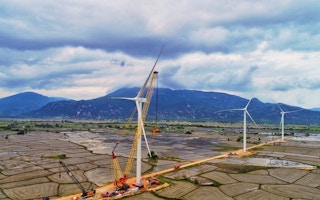Not many paid attention to the release of the Asean Taxonomy for Sustainable Finance at the side-lines of the COP26 meeting in Glasgow last year. The lack of attention belied the weight of the endeavour: the taxonomy is a significant move for Asean and will impact economies and businesses.
The development of the Asean taxonomy was endorsed by Asean finance ministers and central bank governors in March 2021. It is the collective effort of capital market developers, insurance regulators, and finance ministries, who came together to craft a new language of sustainability for Asean.
A taxonomy is a scientific classification system designed to explain the relationship between things. A present-day taxonomy that we are familiar with is the Dewey Decimal system used in libraries. A sustainable finance taxonomy works in the same way by classifying sustainable and non-sustainable investment and economic activities that will spur green growth in an economy. One benefit of having a common sustainability language and benchmarks is to protect against ‘greenwashing’ claims. This makes it easier for institutional investors to take decisions on certain investable activities.
The use of any kind of taxonomy for sustainable finance is still very new in the region. Though Southeast Asian governments have long prioritised national progress and development over the environment, they now recognise the importance of the protection of the environment, public health and climate due to increased public awareness of environmental issues and the devastating climate extremes experienced in the region.
Taxonomies should matter in an economic region of Asean’s size. If Asean were a single economy, it is estimated that on current trajectories it will become the world’s fourth largest economy by 2030 (it is currently in fifth place). Economic growth is typically followed by increases in energy needs and a rise in carbon emissions. Although the region’s share of emissions is currently about 5.6 per cent of global total emissions (calculated according to the WRI Interactive Chart), this figure will likely increase as the region enjoys sustained, strong economic growth. At the same time, climate impacts will increase exponentially in frequency and intensity. Hence there is a strong imperative for Asean to take climate action seriously.
“
A one-size-fits-all approach will make it easy and convenient for regulators. But it will not work for Asean because of different levels in social progress and development.
But why is it important to direct capital and funding in Asean? Fundamentally, there is a recognition that finance is a key enabler of structural economic transformation in a way that will draw investments that will stand up to (green) scrutiny. To achieve climate objectives, it is important to ensure that both private and public finance flows are directed towards sustainable infrastructure and investments — and away from environmentally harmful and unsustainable economic activities. Once common standards are harmonised, it becomes easier for investors, companies, governments, and regulators to make decisions to transition towards a low-carbon future.
Unpacking the ASEAN Taxonomy
The Asean Taxonomy provides a framework for government and private stakeholders to achieve the climate change goals of Asean. It acts as a reference point to guide capital funding towards systemic transformation. But how does one harmonise Asean’s incredibly diverse economic and financial systems — comprising advanced, middle, and emerging economies with different financial systems and policies — and align all the stakeholders to a common goal?
A one-size-fits-all approach will make it easy and convenient for regulators. But it will not work for Asean because of different levels in social progress and development. A principles-based, stacked tier approach was taken to craft the Taxonomy to encourage all member states to come on board and work their way up to more stringent standards. Understandably there is a tension here. If the Taxonomy sets too high a bar, Asean member states who feel they are not up to scratch will not consider using it. If the Taxonomy sets its standards too low, it will encourage complacency and not achieve its climate/ environmental goals, or worse – greenwashing.
The Asean Taxonomy is structured into two tiers — a Foundation Framework and Plus Standards. The Asean Taxonomy is fairly unique in its ‘traffic light’ system — green, amber or red — based on an activity’s contribution to the Taxonomy’s four environmental objectives of climate adaptation, mitigation, protection of ecosystems, and promotion of resource resilience. An activity can thus be classified in six ways: red-amber-green Foundation or red-amber-green Plus Standard. Businesses seeking to invest in new activities in the region will have to study the Asean Taxonomy framework and see how their proposed activity is classified. Financial institutions are also required to be discerning when supporting the flow of capital finance towards certain activities.
Significantly, the Asean Taxonomy can potentially help guide long-term decisions for member states to achieve their national climate goals in line with national environmental laws and policies. It is expected to help structure an orderly and systematic green transition for Asean member states domestically but at a future stage, the taxonomy could also prove useful in promoting a region-wide sustainable transition. The stacked tier approach is therefore a way of taking different national circumstances into account and allowing multiple options for Asean members to scale up according to their comfort levels, in line with the spirit of the Paris Agreement.
But there are challenges facing the implementation of a region-wide taxonomy. The first challenge lies in the availability of data to guide decisions. As the Asean Taxonomy Board itself acknowledges, the absence of data may lead to limited guidance which in turn may be used to ‘greenwash’ certain economic activities. There will also be downstream challenges for users such as asset managers, banks, and insurers. They bear the burden of additional regulatory functions, including climate-related financial disclosures or compulsory maintenance of greenhouse gas (GHG) inventories at the facility level.
Additionally, as the taxonomy continues to be reviewed according to the best available science, users have to exercise due diligence by keeping up with the latest changes. This can be onerous for the millions of micro, small and medium enterprises (MSMEs) operating in the region. For instance, the taxonomy has caveated that there are no available technologies for certain sectors and that specific pathways may have to be created.
Version 1 of the taxonomy only covers key sectors such as agriculture, electricity generation, and manufacturing that are critical to the four environmental objectives of climate adaptation, mitigation, protection of ecosystems, and promotion of resource resilience. It is meant to provide a basis for further consultation with stakeholders which could result in an updated Version 2 soon. In the meantime, it is hoped that the first version will provide a much-needed financial fillip to Asean’s climate change aspirations.
Sharon Seah is a senior fellow and coordinator at the Asean Studies Centre at ISEAS – Yusof Ishak Institute, Singapore.
This article was first published by ISEAS – Yusof Ishak Institute as a Fulcrum commentary.









